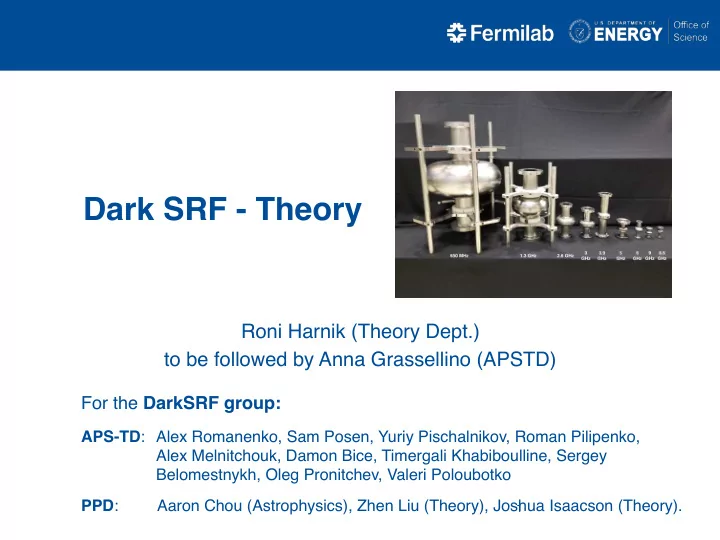

Dark SRF - Theory Roni Harnik (Theory Dept.) to be followed by Anna Grassellino (APSTD) For the DarkSRF group: APS-TD : Alex Romanenko, Sam Posen, Yuriy Pischalnikov, Roman Pilipenko, Alex Melnitchouk, Damon Bice, Timergali Khabiboulline, Sergey Belomestnykh, Oleg Pronitchev, Valeri Poloubotko PPD : Aaron Chou (Astrophysics), Zhen Liu (Theory), Joshua Isaacson (Theory). � 1
Opportunities to Explore Dark Sectors • Fermilab has a unique opportunity to launch a program of exploring dark sectors that couple to EM radiation using SRF technology. Well motivated theories: Well motivated searches: • Dark Photons • Light mediators • Axions and ALPs • Dark matter • Leveraging existing Fermilab infrastructure and expertise. • We are asking the PAC to endorse the physics goals and the effort to use SRF technology for fundamental discovery. � 2
Nature has already ordered Dark Photons γ 0 extra copies of fermions. Why not gauge bosons? • Imagine another photon, with a dark photon different mass. • Common in top-down frameworks. • Any heavy particle that is charged both photons will generate mixing. γ 0 γ L = − 1 ⇣ B 0 ⌘ F µ ν F µ ν + F 0 E 0 + ~ E · ~ ~ B · ~ � µ ν F 0 µ ν − 2 ✏ F µ ν F 0 µ ν � + . . . ⊃ ✏ 4 An oscillating EM field is a source of dark photons, and vice versa. (reminiscent of neutrino oscillations) � 3
Axion-like particles • Imagine an approximate symmetry broken at a high scale f . → a pseudo-Goldstone Boson ≃ an axion-like particle. • Common in top-down constructions, the axion is invoked to solve the strong CP problem. • Loops of heavy charged particles can generate interaction: L = ↵ F µ ν = g a γγ a ~ E · ~ f aF µ ν ˜ B B ⊗ Axions and photons mix in a magnetic field. An oscillating E ⋅ B is a source of dark photons. � 4
Longer Range Interactions and Wave-like Dark Matter • Both axion-like particles and dark photons are well motivated as mediators of long range interactions that can be searched for. L ⊃ dark photons? axions? • Both axion-like particles and dark photons are dark matter candidates with nice production mechanisms. • In the Wave-like DM category. Oscillating at ω = m DM. ⊃ dark photons? axions? � 5
Searches with SRF Cavities • Fermilab’s SRF Cavities are world’s highest quality photon resonators, with Q as high as 10 11 : • Large coherent fields when excited → source dark fields. • Resonant response → amplify coherent feeble signals. Light Shining through wall: A dark matter search: Emitter Receiver Receiver the DM filled Universe a search for a mediator. is the emitter � 6
Dark Photon Search The first simple setup: Receiver Cavity Emitter Cavity � 7
Dark Photon Search The first simple setup: Receiver Cavity Emitter Cavity Frequency of 1.3 GHz, excited to ~ 35 MV/m. Thats ~ 10 25 Photons! � 7
Dark Photon Search a dark photon field is radiated The first simple setup: at 1.3 GHz. Receiver Cavity Emitter Cavity Frequency of 1.3 GHz, excited to ~ 35 MV/m. Thats ~ 10 25 Photons! � 7
Dark Photon Search a dark photon field is radiated The first simple setup: at 1.3 GHz. Receiver Cavity Emitter Cavity Tuned to 1.3 GHz. Frequency of 1.3 GHz, Responds to dark field. excited to ~ 35 MV/m. Contains only thermal Thats ~ 10 25 Photons! noise (T=1.4 K). P rec ∼ G 2 ✏ 4 ⇣ m γ 0 ⌘ 4 For correct cavity positioning Q rec Q em P em ! [see Graham, Mardon, Rajendran, Zhao 2014] � 7
Dark Photon Search Dark SRF @ FNAL 0 CROWS (cavities) - 2 Coulomb - 4 CMB - 6 Log 10 ( ϵ ) D a r ω = 1.3 GHz k S R - 8 F Q = 10 10 @ F e r m t = 2 weeks i l a - 10 b Runs: T = 1.4 K - 12 T = 10 mK Preliminary - 14 - 16 - 14 - 12 - 10 - 8 - 6 - 4 Log 10 ( m γ / eV ) � 8
Dark Photon Search A further search for dark photon DM can follow using a tunable receiver cavity. Receiver Cavity � 9
Axion Searches (future directions) an axion field is radiated at ( f 1 ± f 2 ) . Receiver Cavity Emitter Cavity Excite two modes, Several possibilities to explore: with a non-zero • One excited and one quiet (oscillating) E 1 ⋅ B 2 mode. or • Inserting a region of static B field. search for cosmic DM. • .... R&D is required � 10
On to Anna... � 11
Deleted Scenes � 12
Light Shining through Wall versus a DM Search DM detector Emitter Receiver Assumes the A’ or Independent of whether axion are the DM, but the A’ or axion are the DM. is often more sensitive. No need to scan. Need to scan. Need to tune cavities No need to tune. to one another. � 13
Some References LSTW Graham et al, Phys.Rev. D90 (2014) no.7, 075017 S. R. Parker et al, Phys. Rev. D 88, 112004 (2013) J. Hartnett et al, Phys. Lett. B 698 (2011) 346 J. Jaeckel and A. Ringwald, Phys. Lett. B 659, 509 (2008) � 14
Recommend
More recommend